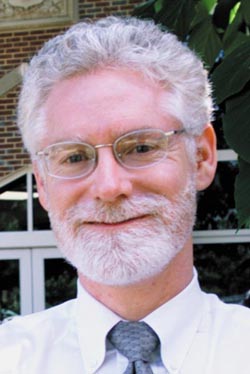
Peter Buerhaus is co-author of the NEJM study.
U.S. nursing shortage continues to affect patients: NEJM
A study linking nurse staffing and patient outcomes that was released a year ago by a Vanderbilt University School of Nursing researcher is gaining significant support, especially since its appearance in the New England Journal of Medicine this month.
The study, originally released April 2001 by the U.S. Department of Health and Human Services, is co-authored by Peter Buerhaus, Ph.D., RN, FAAN, senior associate dean for Research and Valere Potter Professor of Nursing at Vanderbilt University School of Nursing, and Jack Needleman, assistant professor of Economics and Health at Harvard School of Public Health.
The findings from the study, the most comprehensive to date on the topic, show that low nurse staffing directly impacted patient outcomes ranging from urinary tract infections, shock and bleeding.
“It is the largest and most sophisticated study to date assessing the relationship between nurse staffing and quality of patient care,” said Buerhaus. “The Harvard-Vanderbilt study has received considerable attention in the health policy community. The comment of one U.S. Senate staffer summarizes the reaction of many: ‘Because of this study, those of us in the policy community interested in improving the quality of hospital care now realize that we can’t focus solely on the role of physicians, we must also consider the role of nursing and the issues that affect hospital nurse staffing.’”
When the study was first released in 2001 the pair sought to provide evidence that nursing staff matters in what happens to patients. This was in an effort to highlight the need for a change in public policy that would enable hospitals to enrich staffing levels to the point where the adverse patient outcomes that are found could be reduced.
The researchers, utilizing 1997 data from more than 5 million patient discharges from 799 hospitals in 11 states, found that there were consistent relationships between nurse staffing variables and five adverse patient outcomes — urinary tract infections, pneumonia, shock, upper gastrointestinal bleeding and length of hospital stay in medical and major surgery patients.
The study also showed higher RN staffing was associated with a 3 percent to 12 percent reduction in certain adverse outcomes, and higher staffing at all levels of nursing was associated with a 2 percent to 25 percent reduction in adverse outcomes.
This study came nearly one year after Buerhaus released a study in 2000 in the Journal of the American Medical Association projecting that the pool of registered nurses will fall drastically by the year 2020. In comments about the impending shortage, Buerhaus said that the consequences of the lack of staffing put patient care at risk.
“This is an emerging crisis,” he said concerning the shortage. “The demand for health care will increase at a high rate, yet the RN workforce will be decreasing. Clearly, this will create a threat to the access and quality of health care.”
According to the Harvard-Vanderbilt study, the costs associated with patient complications can be substantial. Reductions in the rates of adverse outcomes reduce hospital costs as well as significant financial and psychological costs to patients and their families.
“The publication of this study in the New England Journal of Medicine is providing credibility that nurse staffing has an important effect on the risk that a patient will experience an adverse complication during their hospital stay,” Buerhaus said. “Improving patient safety is a critical issue and our study puts the impact of staffing mix and levels before the nursing profession, hospital industry, insurers and policy makers.”
The Harvard-Vanderbilt study was one of six studies formerly presented by the Department of Health and Human Services before Congress in 2001, and was ranked as one of the top 18 studies done for the HHS. Reference of the report is scheduled to be aired during a “60 Minutes” segment on June 9.













